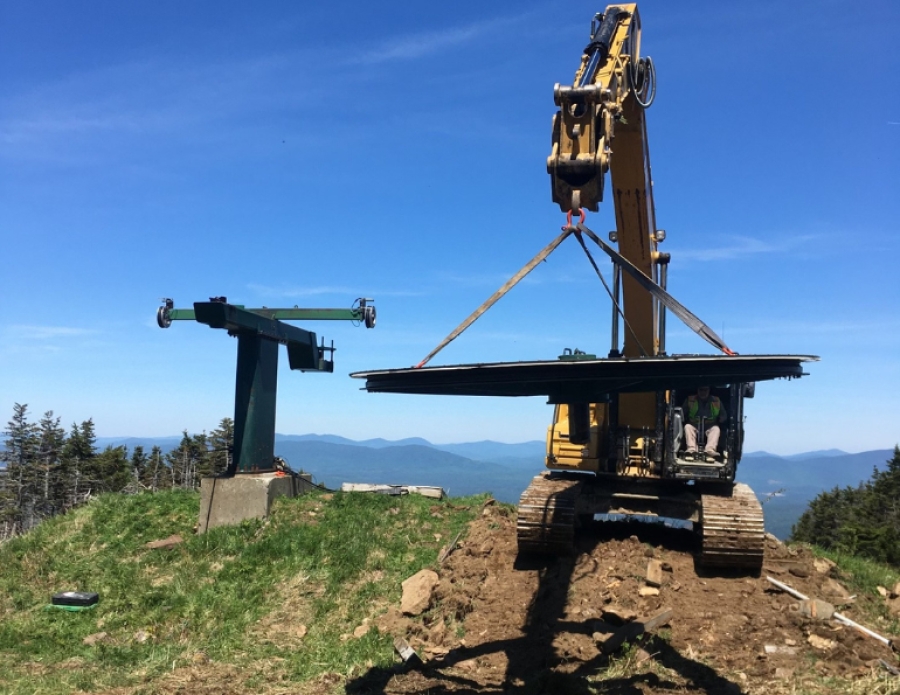Used ski lifts are still finding new homes at North American ski resorts. But the cost of refurbishment, safety concerns, vanishing engineering knowledge, and increasing lift complexity are pushing the industry more in the direction of installing new ropeways, despite their rising costs.
“The used lift market is certainly not what it used to be; it’s almost non-existent today,” says Mike Lane, director of technical services (ropeway engineering) for the National Ski Areas Association.
Data compiled by liftblog.com editor Peter Landsman offers proof of that: while new installs have always outnumbered the repurposing of used lifts, the gap has widened in recent years. Between 2004 and 2015, for example, used lifts represented between a quarter and a third of all installations; in 2022, however, just 7 used lifts were installed versus 59 new ropeways, and in 2023 the used-to-new ratio was 3 to 58.
Landsman cites several factors for this shift. “Some possible reasons include the expense associated with bringing old lifts up to current code and shortage of installation labor; manufacturers’ disinterest in reinstalling or upgrading used lifts when they have strong demand for brand new lifts; and many of the old lifts [coming onto the market] are from manufacturers no longer in business.”
Financing is another driver of the trend, Landsman says. “Conglomerates like Vail, Alterra, and Boyne have more access to capital to invest in new lifts,” he notes.
A MARKET REMAINS
The market for used lifts may be shrinking, but it isn’t dead. Particularly among smaller ski areas with aging equipment, purchasing used can still hit the sweet spot between necessity and budget. Typically, used lifts that meet all the requirements for technology and price were built during the mid-1990s or later.
“A new lift for Woods Valley no longer makes sense financially,” says Tim Woods, president and general manager of Woods Valley Ski Area in Westernville, N.Y. “In 2011, we purchased Woods Valley and had a turn-key lift quoted to replace our prime mover (the Big Chair double) with a fixed-grip quad. The quote at that time was about $850,000. The current estimate for the same lift is over $2 million. To this end, we have been actively searching for used lifts that fit our needs.
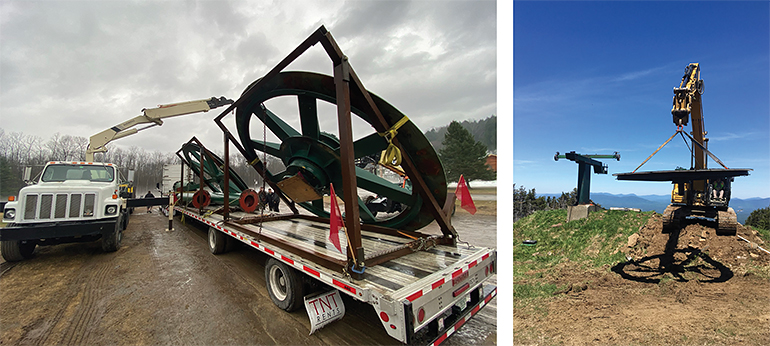 Above: Woods Valley, N.Y., acquired used bullwheels from Saddleback, Maine, for a lift installation.
Above: Woods Valley, N.Y., acquired used bullwheels from Saddleback, Maine, for a lift installation.
“New is always most preferred, but not if it requires a business to be strapped with too much debt,” says Woods, who adds that all of Woods Valley’s major purchases have come out of operating funds. “Even going with a used lift can be very expensive, not to mention the uncertainty that the equipment you have purchased is going to perform as expected.”
Efficient money. “What drives the decision more than anything is money,” says Tim Cohee, president and general manager of China Peak Mountain Resort in Lakeshore, Calif., part of the California Mountain Resort Company (CMRC), of which Cohee is also president. “We’ve purchased and upgraded a triple chair for less than half of what it would cost us new.”
CMRC has been particularly active in the used lift marketplace. Just opened for the 2023-24 season is China Peak’s new Canyon Quad, formerly the Thunder quad at Jackson Hole Mountain Resort, Wyo., itself replaced by an $8-million, high-speed Leitner-Poma detachable quad.
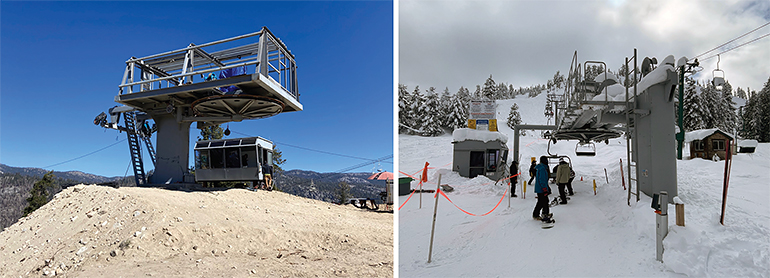 Left to right: China Peak, Calif., installed a fixed-grip quad that was formerly at Jackson Hole, Wyo.; the lift was operational at its new location for the 2023-24 season.
Left to right: China Peak, Calif., installed a fixed-grip quad that was formerly at Jackson Hole, Wyo.; the lift was operational at its new location for the 2023-24 season.
Perhaps the biggest impact of the company’s aggressive (if calculated) pursuit of high-quality used gear will be seen at Bear Valley, purchased by CMRC in 2023. “For an incredibly efficient bit of money, we will totally change the look of the base area at Bear Valley,” says Cohee.
This coming summer, a Poma fixed-grip quad purchased from Taos Ski Valley, N.M., will replace Koala, a Riblet double, and Cohee says the company plans to purchase a fixed-grip quad from Jackson Hole to replace the Super Cub Riblet double chair. A proposed new lift on the south side of the mountain, at Sunrise Bowl, also would come from used stock, he says.
“The whole potpourri of [Bear Valley] lifts came in at well under $2 million,” says Cohee.
MECHANICAL LIFECYCLE
Calculating the costs. Shawn Marquardt, Doppelmayr vice president of sales for North America, says that the cost of moving, reconstructing, overhauling, and upgrading a used lift should all go into the calculus of whether or not to buy new. Those costs cannot be precisely calculated up front, he notes. “On a relocation, you may not be able to identify all of the needs until you get into the details of engineering,” he says. “Things can come up during installation.”
“If you get up to 70 percent of the cost of a new lift, it needs to last at least 70 percent of the life of a new lift,” he says. “Ultimately the buyer has to decide. The older the lift, the tougher those margins get.”
What’s the lift’s condition? “A lot of this comes down to mechanical life cycle,” says Carl Skylling, president of Skytrac, a Leitner-Poma of America subsidiary that, among other things, modifies and retrofits old lifts and assists in relocations. “When you look at every component of the lift, how far into the life cycle is it? If you have a 20-year-old lift and you want it to run for 5 more years, the probability of some sort of failure is probably low. But if you have a 40- or 50-year-old lift, the probability of mechanical failure gets much higher. The only way around that is a major upgrade or refurbishment.”
Some 30-, 40-, and 50-year-old equipment has been meticulously cared for by maintenance staff for decades and remains in excellent working order. Some may be worn out. It can be a challenge to determine where a given lift falls on the spectrum, and that can be a stumbling block.
Many private engineers aren’t willing to take on the risk of a relocation without knowing the maintenance and lift history, says Lane, adding, “The engineering reality is that a private engineer has so much responsibility for a machine they know has already experienced significant cycling fatigue.”
Documentation. That makes good installation and maintenance records extremely important. And finding the original engineering documents for a used lift can pose a challenge, says Ross Stevens, owner of Stevens Engineering, which does planning, designing, and permitting for new and used ski lifts. “We need to submit those [documents] to the state for approval,” says Stevens. “Sometimes we have to recreate those; other times, photos of the equipment are sufficient [to obtain permits].”
Even if some documentation is available, it may not be complete, says Skylling. Ideally, one should have records of past upgrades, incident reports like drive issues and component failures, and maintenance manuals for a used lift that’s to be reinstalled, he says.
“We’re not going to reverse engineer every part if you don’t have the original drawings,” says Skylling. “Show me all of your documentation. How many hours are on the lift? When was the gearbox last overhauled? If you’re 30 years out and there’s never been a rebuild, it will have to be sent out for one.”
Buyers also need to take into consideration the capability of older lifts, says Skylling. “If its mid-’90s vintage, it’s pretty straightforward for us to interface with,” he says. “With older stuff, like the pre-’90s CTEC lifts we work with, there’s less load capacity, so you need more towers to carry that load, which offsets any advantage to using that old equipment.”
Aged out. In short, says Skylling, “We tend to rule out anything that’s older than 1995.”
Marquardt says that Doppelmayr has no hard-and-fast rule about how old is too old for a lift suitable to repurpose. “Our internal guidelines are to go out and do a thorough review of the equipment while it’s still operating,” he says. Obviously, that precludes working on a lift that’s been idled for an extended period of time; it also means that Doppelmayr won’t work on a lift that’s already been disassembled.
ORPHANS AND OLD PARTS
Buying a lift made by a company that’s no longer in business—brands like Yan Lift and Miner-Denver come to mind—also can raise costs or even unexpectedly bring an entire project down if parts cannot be found to bring the lift back online and up to code.
“For all the used lifts coming out, there’s only a small percentage you can justify purchasing from an economic and safety sense,” says Skylling. “Some get ruled out immediately—the manufacturer is long gone, and you can’t get the parts.”
Others, like CTEC, which was founded in 1977 and in business until it was acquired by Garaventa and later Doppelmayr in the 1990s, are relatively easy to work with, says Skylling.
Even true orphans, like lifts from Riblet, in business from 1908 to 2003, are still common enough that parts and engineers can be found to repair and maintain them. Stevens says that its “usually possible”—but not always—to source parts for orphaned equipment.
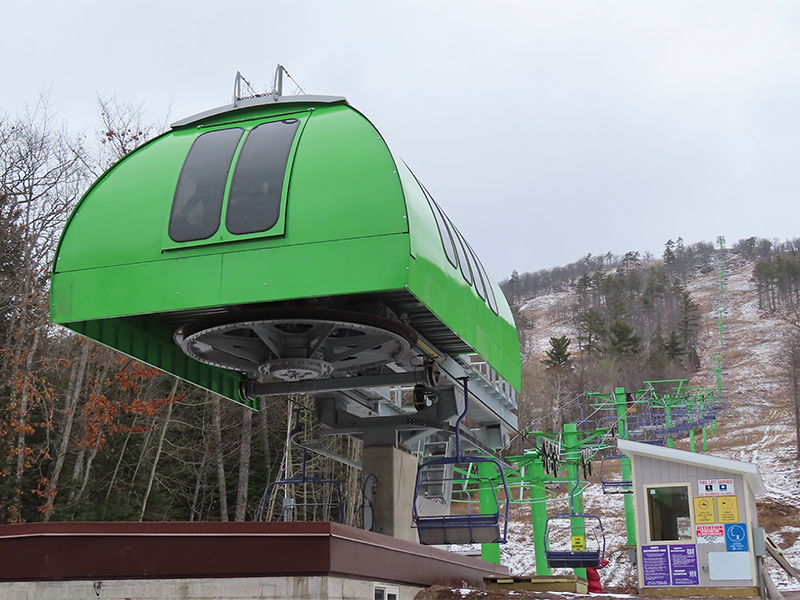 Mount Bohemia, Mich., installed a used Riblet triple when it opened in 2000. The lift has since been upgraded with a new Skytrac drive terminal. Photo courtesy of Peter Landsman
Mount Bohemia, Mich., installed a used Riblet triple when it opened in 2000. The lift has since been upgraded with a new Skytrac drive terminal. Photo courtesy of Peter Landsman
Finding old parts can even be an issue when buying a lift made by Doppelmayr or Leitner-Poma, notes Marquardt. “Especially critical components may no longer be in current production,” he says. “We may have to do a special production run, and that’s more expensive.”
My kingdom for an engineer. Finally, there’s a lack of engineers who are qualified and knowledgeable enough to work on old and exotic lifts. “There are fewer people like me who do the work we do,” says Stevens, adding that his company is well prepared to continue to service older lifts into the foreseeable future.
Skylling agrees. “We as an industry are losing a lot of engineers that had knowledge of these older designs,” he says. “And if an engineering firm isn’t familiar enough with a design, one of them won’t put their stamp on it because they don’t want to jeopardize their license.”
ANSI STANDARDS
One of the biggest challenges to repurposing an old lift is the requirement to bring any lift that has been relocated up to current ANSI standards for passenger ropeways, last revised in August 2022 (ANSI B77.1-2022).
“The rope has to be brand new, you have to go through all the clips and sheave assemblies, and you need a new deck and controls,” says Cohee. “All of the money in lifts is in the terminals and APUs. Towers are not expensive.”
Once that work is done, however, Cohee argues, “you’re basically getting a 1995 [lift] with a lot of the bells and whistles of a 2024 model. You’re buying a lift with a lot of life left in it.”
Pay attention to... Skylling says potential buyers should be particularly attentive to the type of braking systems, tensioning, and control systems a used lift has, and whether they can be brought up to ANSI standards.
For example, “A lot of older lifts were counterweight tensioned,” he says. “A lot of people make the mistake of buying a lift with counterweighting that was separate from the terminal, and you can’t turn those into hydraulic tensioning, so you end up having to put a big column behind the terminal.”
Likewise, some older lifts used a low-voltage control system paired with a high-voltage drive. In such cases, an ANSI-ready refit will require the purchase of a new AC drive and motor, says Skylling. “That’s not usually a showstopper, but it is something you can wrap a lot of money into,” he warns.
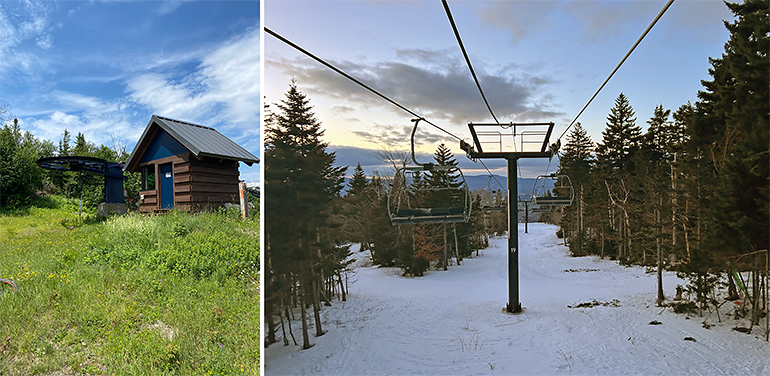 Left: A shortened Borvig lift at Sugarloaf, Maine, is being repurposed onsite in the West Mountain terrain expansion. Right: Installation of a Poma quad, relocated from Stratton Mountain, Vt., is nearing compeletion at Magic Mountain, Vt., says Stevens Engineering. Photos courtesy of Stevens Engineering
Left: A shortened Borvig lift at Sugarloaf, Maine, is being repurposed onsite in the West Mountain terrain expansion. Right: Installation of a Poma quad, relocated from Stratton Mountain, Vt., is nearing compeletion at Magic Mountain, Vt., says Stevens Engineering. Photos courtesy of Stevens Engineering
HERE COME THE DETACHABLES?
While fixed-grip lifts have comprised the entirety of the used market for the past two decades, that’s beginning to change. “We are getting into an era when the first generation of high-speed detachable lifts are now being replaced, equipment from the late 1990s,” says Marquardt. “The first-generation technology is now at the 30-year mark and reaching the end of its life.”
However, while there certainly are buyers willing to kick the tires on a used detachable lift, experts warn that this equipment is an order of magnitude more technologically complex than the fixed-grip lifts that have dominated the used market up to this point.
“People say reinstalling an old detachable is suicide,” says Cohee. “We’ve been waiting for a good detachable to install,” he says, adding that so far “the answer has always been ‘no.’”
Sticky wickets. “The problem with the detachables that began hitting in the late 1980s and early 1990s was that the first ones were custom-built, so you can’t find parts easily,” says Skylling. “Modular design didn’t start happening until 1993-97. With what you’re starting to see hit the market now, the critical component question is even more complicated, such as the grips—there are some grips that would be extremely costly to replace.
“First, I’d ask if I can get these parts from the manufacturer. I’d stick to lifts from the late 1990s or later—anything older than that, you don’t want to mess with,” he concludes.
Bottom line. Whether for a fixed-grip or detachable, the cost-benefit analysis that goes into consideration of a used lift has become more involved. But used lifts can still be a value, as Cohee and other owners have shown. Making that determination, though, requires a lot of planning and rigorous attention to detail—to all the details, in fact.





